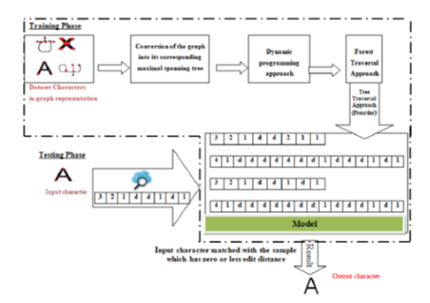


Indian Journal of Science and Technology
DOI: 10.17485/IJST/v15i27.2405
Year: 2022, Volume: 15, Issue: 27, Pages: 1336-1343
Original Article
M J Roopa1*, K Mahantesh2
1Department of Computer Science and Engineering, SJB Institute of Technology, Bangalore-
560060, Karnataka, India
2Department of Electronics and Communication Engineering, SJB Institute of Technology,
Bangalore-560060, Karnataka, India
*Corresponding Author
Email: [email protected]
Received Date:23 December 2021, Accepted Date:22 February 2022, Published Date:14 July 2022
Objectives: Graph Edit distance-based classification and recognition method is introduced in this study for bilingual characters. Specifically, this method aims to classify characters first and then recognize them in the 2nd level. Methods: This study combines both exact graph matching and inexact graph matching techniques to achieve better Recognition. The exact graph matching technique classifies characters by considering the number of vertices and edges as features to classify. Inexact graph matching uses an algorithmic model to measure the degree of similarity in the length of edit operations. Findings: The proposed model can compute, if not optimal, sequences all the time, at least near-optimal edit sequence. The proposed model is based on dynamic programming. Edit distance is estimated by comparing preorder sequences of the respective binary trees. Finally, this model uses the loss function to recognize text accurately. To bring out the practicality of the proposed model, we present a case study on the classification of English alphabets and Kannada conjunct consonants. Novelty: (i) A hybrid approach for converting a large class classification problem into a small classification problem that takes advantage of both exact and inexact graph matching techniques. (ii) An algorithmic model is designed to represent each character as a unique string. (iii) Uses dynamic programming in the right places to get the optimal tree, and (iv) to convert the graph matching problem to a string matching problem reduces the time complexity of the problem.
Keywords: Bilingual text; Character Recognition; Degree of Similarity; Graph Edit Distance; Graph Matching
© 2022 Roopa & Mahantesh. This is an open-access article distributed under the terms of the Creative Commons Attribution License, which permits unrestricted use, distribution, and reproduction in any medium, provided the original author and source are credited.
Published By Indian Society for Education and Environment (iSee)
Subscribe now for latest articles and news.